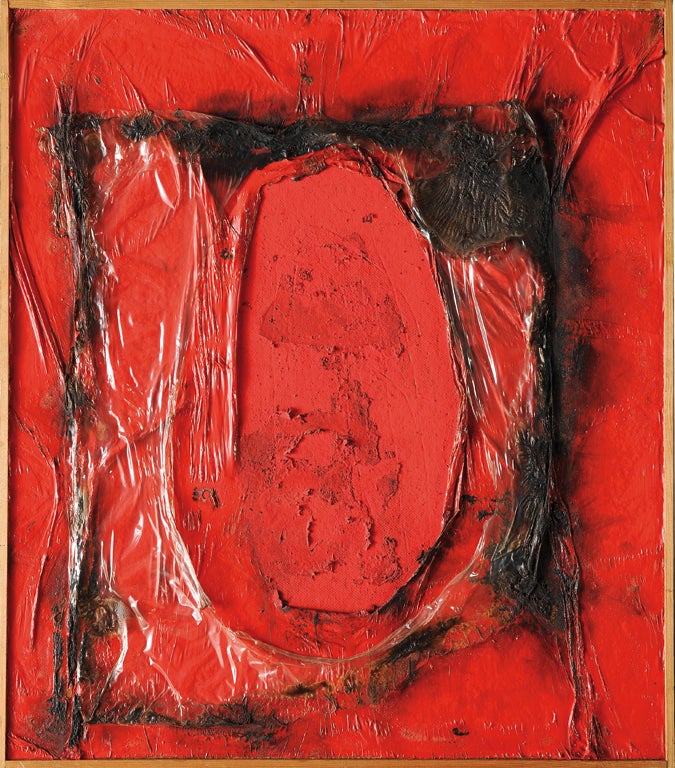Back to the Futurists
Other nations may have made abstract art famous, but the work from Italy reached new heights of excitement and passion. By Adrian Hamilton

One of the best small shows of the year was the exhibition of Alberto Burri at the Estorick Collection in north London. Suddenly, and shockingly, you were presented with an Italian abstract artist (1915-1995) of considerable stature abroad but whose works were largely unknown in this country. It was a revelation.
Now the Estorick has capped this with a broader, and in its way just as revelatory, show, In Astratto: Abstraction in Italy 1930-1980. Burri isn't present, but his associate in the Arte Povera group, Lucio Fontana, is with two glorious studies in Spatial Concept, the mixed-media swirling and jabbing on the canvas. So too are many of the artists which succeeded the Arte Povera and Futurist movements.
Bliss must it have been to be alive and an artist in the 1920s and 1930s when Cubism and Modernism seemed to make all things possible. While the First World War, in which Italy lost 650,000 dead and nearly one million wounded in a quite unnecessary conflict with Austria, had blighted the hopes that had accompanied Italy's great acclamation of the modern technical world in the Futurist movement. But it led, not to pessimism as in Britain, and angst as in Germany, but a desire for rationality and detachment, a belief that art could somehow re-establish a spiritual message of universalism and order.
Being Italian, the artists of Milan, Genoa and Rome barely met before dubbing themselves with a name and a spirited manifesto. Futurism, with its emphasis on the mechanical, ironically opened the way. Although it was a firmly figurative art, leading directly to the cool neo-classicism of Gino Severini and others, it was also in many ways an geometric one. The Milione Group in Milan, influenced by the works of Mondrian and Kandinsky, advocated a language in which the presence of the artist was entirely absent. "Art," declared the philosophical father of the movement, Carlo Belli, in his book Kn, "is. It therefore is nothing else outside itself. Art is not pain, pleasure, hot, cold. It is in no way a human fact. The work of art cannot tolerate the intrusion of the author."
The Second World War only had the effect of reinvigorating abstract art. Out was figurative and classical art, with its connotations of Fascist prescription. In was art that was classless and free of the past. The Rome Forma 1 group rejected pure geometry in favour of instinctive and even lyrical patterns. The Movimento Arte Concreta (MAC) went the opposite direction, promoting works that had no connection with real objects or organic shapes while the Europe-wide Art Informel, boosted by the example of the American Abstract Expressionists, gloried in rhythm and a painterliness that their Abstract forebears religiously eschewed. Overwhelmed by a showing of the US abstract artist, Yves Klein, Piero Manzoni went towards the negation of colour altogether. Art he argued emphatically "should be … a white which is in no sense a polar landscape, an evocative or even merely beautiful pictorial, a sensation or a symbol, or anything else of the kind; a white surface which is a white surface and nothing else… indeed, better still, a surface which is and nothing else: being."
If all this sounds a bit too conceptual be not afeared. Just as Italian Futurism in artistic practice was far more exciting and passionate than the philosophy might have suggested, so it was with abstract art in Italy. The words might seem abstracted but the paintings are full of texture, colour and life. Even in those works closest to Mondrian in their controlled compositions there is a sense of rhythm in the angularity. Gino Ghiringhelli, a leading light of the Milione group, subverts the severity of his Composition No. 5 from 1934 with pastel colours and leaning shapes that makes the composition one of real objects not regimented space. Mauro Reggiani, another of the early pioneers, enlivens his vertical and horizontal rectangles in Composition No. 3 from 1935 with a diagonal line and two-coloured opposing rectangles in a way that Mondrian or Ben Nicholson would never have allowed, just as Osvaldo Licini teasingly titles his works Rhythm (1932) and Joke (1933) in recognition of the way he uses colour and unexpected line breaks to intrigue the onlooker.
Standing in a room of these small pictures, it is impossible not to sense a southern eye if nothing else in the matt greens, browns and ochre. Their size helps, giving them an intimacy the larger works of abstract art lose.
There are some big names among the 65 works on display and a lot of ones hardly known over here. But there's nothing homogenous about the paintings. Grouped together like this they give a wonderful sense of an art of optimism.
In Astratto: Abstraction in Italy: 1930-1980, Estorick Collection, London N1 (020 7704 9522 ) to 9 September
Subscribe to Independent Premium to bookmark this article
Want to bookmark your favourite articles and stories to read or reference later? Start your Independent Premium subscription today.

Join our commenting forum
Join thought-provoking conversations, follow other Independent readers and see their replies